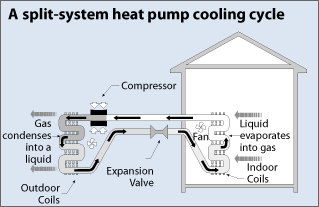DSO Electric Cooperative Inc. | 201 Dakota Drive | Solomon, KS 67480 | PO Box 286 | 1-800-376-3533
An air-source heat pump can provide efficient heating and cooling for your home, especially if you live in a warm climate. When properly installed, an air-source heat pump can deliver one-and-a-half to three times more heat energy to a home than the electrical energy it consumes. This is possible because a heat pump moves heat rather than converting it from a fuel, like in combustion heating systems.
Although air-source heat pumps can be used in nearly all parts of the United States, they do not generally perform well over extended periods of sub-freezing temperatures. In regions with sub-freezing winter temperatures, it may not be cost effective to meet all your heating needs with a standard air-source heat pump.
However, new systems with gas heating as a backup are able to overcome this problem. There is also a "Cold Climate Heat Pump" which shows promise, but is currently facing manufacturing problems. In addition, a version called the "Reverse Cycle Chiller" claims to be able to operate efficiently at below-freezing temperatures. In cooling mode, an air-source heat pump evaporates a refrigerant in the indoor coil; as the liquid evaporates it pulls heat from the air in the house. After the gas is compressed, it passes into the outdoor coil and condenses, releasing heat to the outside air. The pressure changes caused by the compressor and the expansion valve allow the gas to condense at a high temperature outside and evaporate at a lower temperature indoors.


